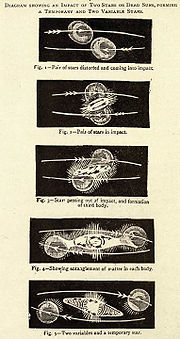
Partial impact theory
Encyclopedia

Astronomy
Astronomy is a natural science that deals with the study of celestial objects and phenomena that originate outside the atmosphere of Earth...
theory describing the partial collision of two star
Star
A star is a massive, luminous sphere of plasma held together by gravity. At the end of its lifetime, a star can also contain a proportion of degenerate matter. The nearest star to Earth is the Sun, which is the source of most of the energy on Earth...
s and the temporary creation of a bright third star
Star
A star is a massive, luminous sphere of plasma held together by gravity. At the end of its lifetime, a star can also contain a proportion of degenerate matter. The nearest star to Earth is the Sun, which is the source of most of the energy on Earth...
as a consequence. The theory was explained in Alexander William Bickerton
Alexander William Bickerton
Professor Alexander William Bickerton was the first professor of Chemistry at Canterbury College in Christchurch, New Zealand. He is best known for teaching and mentoring Ernest Rutherford. He was a natural teacher though an eccentric one, who taught science in an exciting way...
's book The Romance of the Heavens published in 1901.
Partial impact theory
In The Romance of the Heavens BickertonAlexander William Bickerton
Professor Alexander William Bickerton was the first professor of Chemistry at Canterbury College in Christchurch, New Zealand. He is best known for teaching and mentoring Ernest Rutherford. He was a natural teacher though an eccentric one, who taught science in an exciting way...
states that a slight "grazing" collision between stars would be much more common than a head on impact between stars. So he believed this phenomenon needed to be explained to account for the appearance of bright new stars that would appear in the night sky and disappear within a year or even days.
The theory explains that when the two stellar
Stellar
Stellar is an adjective referring to one or more stars. It may also refer to:* Hyundai Stellar, a car built by Hyundai Motor Company* "Stellar*", a New Zealand-based rock band.* "Stellar" , a song by Incubus...
bodies graze each other, the grazed parts will shear off from the main body of each star. Their velocity will cancel each other's out transforming this energy into heat. While the main mass of each star will continue moving as they did before the collision. The third body created from the two sheared parts of the stars will form between the two original stars.
The temporary star expands after the impact displaying an intense increase in light, after all molecular reactions have taken place the light is replaced by a hollow shell of gas or possibly a planetary nebula
Planetary nebula
A planetary nebula is an emission nebula consisting of an expanding glowing shell of ionized gas ejected during the asymptotic giant branch phase of certain types of stars late in their life...
, and eventually dissipates into space
Space
Space is the boundless, three-dimensional extent in which objects and events occur and have relative position and direction. Physical space is often conceived in three linear dimensions, although modern physicists usually consider it, with time, to be part of a boundless four-dimensional continuum...
. Bickerton
Alexander William Bickerton
Professor Alexander William Bickerton was the first professor of Chemistry at Canterbury College in Christchurch, New Zealand. He is best known for teaching and mentoring Ernest Rutherford. He was a natural teacher though an eccentric one, who taught science in an exciting way...
explains this bright temporary star by saying that it doesn't disappear due to cooling, but that it was too hot to hold together.
The temperature of the third star, isn't dependent on the amount of contact between the two original stars, but rather the chemical makeup of the stars and their velocities going into the collision. The stability of the third body depends on the size of the contact of the original stars, if the contact was small then the mass of the newly created third body will find it harder to attract molecules to it. Rather than if it had a larger mass where molecules would find it more difficult to escape from its larger gravitational pull.

